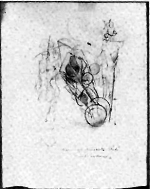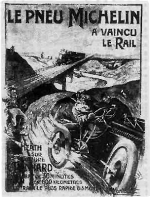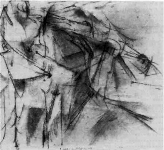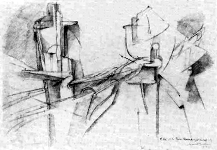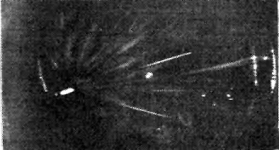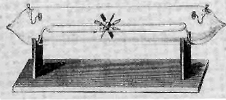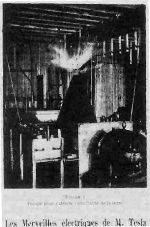Winter 1997, Volume 14.1
Essay
Linda Dalrymple Henderson
Marcel Duchamp's The King and Queen Surrounded by Swift Nudes (1912) and the Invisible World of Electrons
Linda Dalrymple Henderson (Ph.D., Yale U) is Professor in the Department of Art and Art History at the University of Texas at Austin. She is the author of The Fourth Dimension and Non-Euclidean Geometry in Modern Art (Princeton UP, 1983) and Duchamp in Context: Science and Technology in the "Large Glass" and Related Works (Princeton UP, forthcoming). A Guggenheim Fellow in 1988-89, she has also published essays in numerous exhibition catalogues and art history journals.
[Click on pictures to enlarge.]
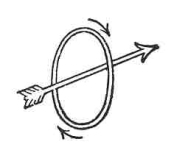
Figure 10: Corkscrew Rule, from Silvanus P.
Thompson, Lecons elementaires d'electricite
et de magnetisme, Paris, 1898, fig 108.
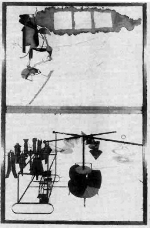
Figure 11: Marcel Duchamp, The Bride Stripped Bare by Her Bachelors, Even (The Large Glass). 1915-1923, oil, varnish, lead wire, lead foil, mirror silvering, and dust on two glass panels (cracked), each mounted between two glass panels, with five glass strips, tinfoil, and a wood and steel frame, 109 1/4 x 69 1/4 in. (277.5 x 175.8 cm.), Philadelphia Museum of Art, Bequest of Katerine S. Dreier (Photo: Philadelphia Museum of Art).
Marcel Duchamp's well-known painting of early 1912, Nude Descending a Staircase [No. 2] (fig. 2), stands as his first fully realized response to Cubism's pursuit of the invisible realities suggested by the discovery of X-rays in 1895.1 At the same time, Duchamp deliberately distinguished that work from the Cubist style by incorporating both a figure in motion (virtually never seen in Cubism) and the humorous implications of X-ray stripping (here both the clothing and flesh of the nude disappear). After his completion of the Nude in January, Duchamp's exploration of motion and the invisible entered a new phase. In March 1912 he began a series of works on paper on the theme of "Swift Nudes," which culminated in his May 1912 painting The King and Queen Surrounded by Swift Nudes (fig. 1). These preparatory works include two pencil drawings, 2 Nudes: One Strong and One Swift of March 1912 (fig. 5) and The King and Queen Traversed by Swift Nudes of April 1912 (fig. 6), and a watercolor and gouache study, The King and Queen Traversed by Nudes at High Speed of April 1912 (Philadelphia Museum of Art, The Louise and Walter Arensberg Collection).2 Having long eluded any interpretation beyond the themes of speed, nudity, and chess suggested by their titles, this series becomes far more meaningful when considered in the light of contemporary science and, particularly, research related to electrons and electricity.3
In contrast to what Duchamp termed the "static representation of movement" in the Nude Descending a Staircase (Sweeney, "Eleven Europeans" 20), the emphasis in these new works was on speed and fluid motion. Duchamp's new interest in speed was undoubtedly stimulated by the most dramatic artistic event of early 1912 in Paris, the Italian Futurists' February exhibition at the Galerie Bernheim-Jeune. From Marinetti's "Founding Manifesto of Futurism" of 1909, which dramatically extolled the "beauty of speed" and "a racing car whose hood is adorned with great pipes, like serpents of explosive breath" (Marinetti 21), through the numerous paintings shown in the Futurists' exhibition treating themes of modern transportation, Futurism glorified the intensity and speed of modern experience. Indeed, Duchamp's small drawing, 2 Personages and a Car (Study) (fig. 3), may well be a response to Futurist ideas as well as to popular images of "automobilisme" such as a 1906 Michelin advertisement that likewise emphasizes speed by means of an automobile at a diagonal contrasted to a stationary viewer (fig. 4).
With its two flanking figures, the drawing 2 Personages exhibits a basic structural resemblance to Duchamp's painting The King and Queen Surrounded by Swift Nudes, and it is likely the precursor of the "Swift Nudes" series. As an overt depiction of popular technology, however, the drawing is unusual among Duchamp's works. Although the theme of the automobile would figure importantly in his conception of the Bride in his major work, The Bride Stripped Bare by Her Bachelors, Even (The Large Glass) (1915-23), on which he would commence work in fall 1912 (fig. 11), Duchamp would never again treat the automobile in such a specifically "Futurist" manner. Instead, he left behind Futurist notions of speed to explore a velocity far surpassing that of a mere machine: that of the electron.
In 1897 J. J. Thomson had established the existence of "corpuscles" of electricity, or electrons, in the course of his cathode ray research.4 As a further stage in the "denuding" of matter, electrons were widely studied by scientists and became the subject of a surprising amount of popular literature as well. Before examining what scientific literature may have offered Duchamp on the subject of electrons as well as means to give visual form to electricity, it is useful to review the artist's own later statements on the significance of the "Swift Nudes" series. In addition, Guillaume Apollinaire's discussion of Duchamp's works of this period in his Les Peintres Cubistes of 1913 is revealing and supports the thesis that science had come to play an increasingly central role in Duchamp's thinking.
In a 1962 interview Duchamp contrasted the King and Queen to his Nude Descending a Staircase, explaining, "Here 'the swift nudes,' instead of descending, were included to suggest a different kind of speed, of movement—a kind of flowing around and between the central figures. The use of nudes completely removed any chance of suggesting an actual scene or an actual king and queen" (Kuh 88). Later in the 1960s, in discussing the King and Queen painting with Pierre Cabanne, Duchamp further distinguished the two works: "Obviously the difference was the introduction of the strong nude and the swift nude. There was the strong nude who was the king; as for the swift nudes, they were the trails which crisscross the painting, which have no anatomical detail, no more than before" (Cabanne 35). And, as he told Arturo Schwarz in the same period: "I expected to render the idea of a strong king, or a male king and a feminine queen, a female queen. And the nudes were not anatomical nudes, rather things floating around the King and Queen without being hampered by their materiality" (Schwarz 116).
Apollinaire's text on Duchamp was included in the second half of Les Peintres Cubistes, in the midst of similar brief essays on Pablo Picasso, Georges Braque, and the circle of Puteaux Cubists with which he was associated for a time. Since Duchamp had become increasingly close to Apollinaire during later 1912, the critic's remarks provide important clues to his thinking in this period. Like the other new painters, Apollinaire notes, Duchamp "has abandoned the cult of appearances"; "he uses forms and colors, not to render appearances, but to penetrate the essential nature of forms and formal colors." In contrast to his discussions of the other Cubist painters, however, Apollinaire emphasizes Duchamp's intellect, noting that he writes directly on the canvas "an extremely intellectual title" and "is not afraid of being criticized as esoteric or unintelligible" (47). According to Apollinaire,
An art directed to wresting from nature, not intellectual generalizations, but collective forms and colors, the perception of which has not yet become knowledge, is certainly conceivable, and a painter like Marcel Duchamp is very likely to realize such an art.
It is possible that these unknown, profound, and abruptly grandiose aspects of nature do not have to be aestheticized in order to move us; this would explain the flame-shaped colors [l'aspect flammiforme des couleurs], the compositions in the form of an N, the rumbling tones, now tender, now firmly accented. These conceptions are not determined by an aesthetic, but by the energy of a few lines (forms or colors).
Just as Cimabue's pictures were paraded through the streets, our century has seen the airplane of Blériot, laden with the efforts humanity made for the past thousand years, escorted in glory to the Arts-et-Métiers. Perhaps it will be the task of an artist as detached from aesthetic preoccupations, and as preoccupied with energy as Marcel Duchamp, to reconcile art and the people. (Cubist Painters 47-48; Peintres Cubistes 73-76)
Apollinaire included The King and Queen Surrounded by Swift Nudes among the illustrations of Duchamp's works in Les Peintres Cubistes, and his reference to "compositions in the form of an N," the basic structure of the King and Queen painting (fig. 1), further links his comments to the "Swift Nudes" series. As with Apollinaire's earlier reference to Duchamp's desire "to penetrate the essential nature of forms," here the talk of "unknown, profound, and abruptly grandiose aspects of nature" ("the perception of which has not yet become knowledge"), of Duchamp's "preoccupation with energy," and even the "flame-shaped colors" points to electrons and the science of electromagnetism, as will be seen. Further, Apollinaire provides a direct clue to one of Duchamp's important sources of scientific information: the "Arts-et-Métiers," the Conservatoire Nationale des Arts et Métiers and its museum. Filled with the equipment of physics and chemistry as well as recent technology (e.g., wireless telegraphy, automobiles, and airplanes such as that of Louis Blériot who had crossed the English Channel in 1909), the Arts et Métiers would have provided a wealth of images and ideas for Duchamp.
Apollinaire was undoubtedly referring to Duchamp's growing interest in science and technology (encoded in the phrase "preoccupation with energy"), when he suggested that Duchamp might be the one artist who could "reconcile art and the people." In contrast to the "aesthetic preoccupations" of artists and the art world, here was an artist who, like the average Frenchman, was more excited by Blériot's airplane than by the masterpieces in the Louvre. After 1912 Duchamp would execute only a few works in the traditional medium of oil on canvas, and the equipment of science and technology would come to play a central role in his image making. In the end, however, reconciling art and people was not Duchamp's goal in these works, which have more often than not mystified their audience and concealed their specific scientific or technological roots.
If Apollinaire's prediction was incorrect, his text nevertheless provides a near-contemporary reflection of Duchamp's interests at the time of the "Swift Nudes" series. Already in these works aesthetic sources have been replaced by scientific ones, but it is the processes uncovered by science and not yet the equipment of science or technology on which Duchamp concentrates. Indeed, Duchamp's drawings and paintings of spring 1912 and certain of those of summer 1912 are unified by their debt to the scientific developments Duchamp had first encountered in the extensive literature on X-rays: electrons as studied in research on cathode rays and radioactivity, as well as electric sparks.5
Unlike X-rays, the cathode rays that generated them had never attracted widespread public attention. "Cathode rays have no practical application" A. Dastre had declared in the Revue des Deux Mondes in 1901 (695), never suspecting the central role cathode ray tubes would come to play in the yet undeveloped field of electronics—from television tubes to computer screens. Yet, during the first decade of the century the electrons Thomson had demonstrated to be the components of the "ray" flowing from the cathode to the anode of a Crookes tube had gained increasing attention. The existence of such infinitesimal particles, "less than one-thousandth part of the mass of an atom of hydrogen" stimulated much new theorizing about the nature of matter and electricity (qtd. in Keller 66). Most importantly, as Thomson concluded in 1897, atoms were not indivisible, as had been thought, but contained "negatively electrified particles [that] can be torn from them by the action of electrical forces" (Keller 66).
Beyond the insights Thomson and others continued to draw from cathode ray research, the discovery of radioactivity and, particularly, the contributions of Ernest Rutherford added important new information to the puzzle of the atom during the early years of the century.6 The beta "rays" Rutherford had identified as one of the radioactive emissions were discovered to be streams of electrons like cathode rays, and the alpha "rays" were found to be positively charged particles. Thus, the popular literature on radioactivity and, in France especially, the related writings of Gustave Le Bon, such as his best-selling L'Évolution de la matière of 1905, further stimulated interest in atom theory and electrons. It was suggested that the electron might be the fundamental unit of all matter, or, as Sir Oliver Lodge, the widely published British physicist, declared in 1904, "Matter then appears to be composed of positive and negative electricity and nothing else."7
Physics now offered a new challenge to the imagination of the artist, the invisible reality of the electron within the atom. Despite the "hopeless invisibility of an atom" (Williams 117), there were certain themes that emerged from scientific and popular discussions of the electrons composing cathode rays and radioactive beta emissions. Indeed, the image of electrons as projectiles whizzing at enormous velocities dominated popular discussions of cathode rays from 1896 onward. And, once Thomson's experiments determined that the speed of the electron was over 10,000 kilometers per second and it was subsequently determined that radioactive beta emissions traveled even faster, figures as high as 100,000 miles (160,000 kilometers) per second and more were regularly cited as electron velocities.8
There were also a number of hypothetical models of atomic structure put forward, including Thomson's conception of electrons embedded throughout the atom like pieces of plum in a plum pudding. Others proposed structures of the planetary type, which Rutherford would establish experimentally and announce in March 1911, clarifying at the same time the small size of the central area of positive charge (i.e., the nucleus) in relation to the atom as a whole.9 Thus, in the decade before Rutherford's announcement, the general analogy of the atom to the solar system was already widely discussed in the writings of figures such as Lodge and Joseph Larmor, as well as Jean Perrin, Le Bon, and others. For example, Lucien Poincaré writes in his survey of contemporary physics, La Physique moderne, son evolution of 1907: The atom may be regarded as a sort of solar system in which electrons in considerable numbers gravitate around the sun formed by the positive ion. The phenomena of the emission of light compels us to think that the corpuscles revolve round the nucleus with extreme velocities, or at the rate of thousands of billions of evolutions per second. It is easy to conceive from this that, notwithstanding its lightness, an atom thus constituted may possess an enormous energy. (286)
That such a realm could offer stimulation to a writer or artist is confirmed in an October 1908 article in Mercure de France entitled "Histoire extraordinaire des Électrons." The author, Georges Matisse, begins his text by recalling Henri Poincaré's remark on assuming the presidency of the Société Française de Physique several years before that it was "a great source of joy, of pure intellectual satisfaction to be able to follow the fantastic progress of physical science at the beginning of the twentieth century" (744). Matisse continues, arguing that physics is indeed "full of marvelous tales":
One of these especially seems made to bring to the soul of the artist the "pure intellectual satisfaction" of which Poincaré speaks: it is called, I believe, Extraordinary adventures or Theory of electrons. Electrons are charming, petite beings who recall the elves and trolls of Scandinavia. They are extremely tenuous: 1000 times smaller than the hydrogen atom, say some; 2,000 times, claim others Large numbers of these electrons, dressed in negative electricity, are the subjects of a king for whom they form the court. This monarch is a large atom wearing a cloak of positive electricity, not a common atom, but the quintessence which remains after a certain number of light and "short-skirted" particles have detached themselves from him. Around the royal highness hover and whirl his courtiers, negative electrons, who waltz rapidly in his presence.
Matisse's text then adds the idea of a queen as well as the dematerialization of matter posited by Le Bon:
Observing them [the electrons], it is impossible not to think of the charming fairy scene of Giselle, conceived by Théophile Gautier. All night [the spirits] dance furiously, flying and whirling around their queen. Untiringly, they continue to dance until dawn, when they disappear into the plants from which they had emerged. Our electrons are like them: after having agilely turned about for a certain time, they disappear, recombine themselves and return into the atom from which they had left. J. J. Thomson has calculated "the mean duration of freedom—"one might say the life—of a corpuscle. This life is very short, shorter than that of the ephemerids; however, many are reborn after their death. M. Gustave Le Bon has wondered if some family relationship does not exist among ordinary atoms, ions, electrons, X-rays, and energy. Well, if so, there is an intimate one: matter dematerializes little by little; it disincarnates itself, as a spirit ist would say. An atom becomes an ion, an ion becomes an electron, then an X-ray, and, finally, energy and ether (744-45).
After further discussion of the wonders of electrons, Matisse concludes with the affirmation, "Rejoice with Poincaré that we live in the twentieth century: this will be the century of electrons" (746). Such imaginative, anthropomorphic discussions of electrons surely lie behind Duchamp's conception of the series culminating his painting The King and Queen Surrounded by Swift Nudes. In Matisse's article, in particular, the inclusion of Poincaré's statement that recent physics is a potential source of "pure intellectual satisfaction" was tailor-made for Duchamp at this moment. Already an admirer of Poincaré, he was now determined "to get away from the physical aspect of painting" and "to put painting once again at the service of the mind" (Sweeney, "Eleven Europeans" 20).
There is a striking conjunction between electron theory as presented in sources such as Matisse's article and Duchamp's own statements on the "Swift Nudes." As described by Matisse, electrons are not only swift, they are nude—"dressed in negative electricity." These courtiers, "a procession of rapidly moving nudes" ("French Artists" 3), as Duchamp described them in 1915, flow around and between the central figures, including, as Duchamp stated, "the strong nude who was the king" (Cabanne 35).10 In the context of electrons and atom theory, the "strong nude" in Duchamp's first drawing of the series, 2 Nudes: One Strong and One Swift (fig. 5), suggests not only a king but also the strong positive charge at the center of the atom that binds the swift negative electrons in their whirling orbits.11
In subsequent drawings the "Swift Nudes" become accessories to a royal pair, a king and queen (associated also with chess), "surrounding" or "traversing" them, "without being hampered by their materiality" as Duchamp later explained (Schwarz 116). The term "traverse" was the standard term in discussions of the activity within an atom by Rutherford, Perrin, and others.12 Duchamp's words also bring to mind Matisse's talk of electrons detaching themselves from and reentering the sphere of the atom's charge and his subsequent discussion of the dematerialization of matter. The "Swift Nudes" are "unhampered by [the] materiality" of the king and queen, just as Le Bon, basing himself on Lodge, Larmor, Hendrik Lorentz, and others, asserted that the electron "has no property in common with matter, except a certain inertia varying with the velocity, [and] is more like ether than matter and forms a transition between them" (Le Bon, "L'Énergie" 498-99). In this view, the electron was indeed a "bare" charge. Le Bon saw the material atom as an "enormous condensation" of "intra-atomic energy" ("L'Énergie" 493) in the gradual process of dematerializing back into the ether, as electrons and other radioactive emissions escaped from the atom. Matisse's text noted the formation of ions (an atom or molecule that has lost or gained electrons and is thus positively or negatively charged) as a stage in this process. Duchamp's later reference to "trails which crisscross the painting" further strengthens the interpretation of the "Swift Nudes" as charged particles or electrons. Although in spring 1912 it would have been quite early for Duchamp to have known of the British scientist C. T. R. Wilson's "cloud chamber," Wilson's work in tracing the paths of ionising particles offers an interesting parallel to Duchamp's concerns in the "Swift Nudes" series.
Wilson had collaborated with J. J. Thomson in the 1890s in his research on the ionization of gases by X-rays, and in 1911 it was Wilson's cloud chamber that enabled Rutherford to determine the characteristic paths of the various radioactive emissions.13 In the cloud chamber Wilson was able to produce water condensation around the ions generated by the passage of charged particles or X-rays, resulting in vapor trails that could be recorded photographically (fig. 7). In his first publication of two such photographs in November 1911, "On a Method of Making Visible the Paths of Ionising Particles Through a Gas," Wilson had referred to his images as the "tracks" of individual particles and the "traces of ions" left by them.14 Yet, it is hard to imagine how Duchamp in spring 1912 would have known of this first Wilson article in the Proceedings of the Royal Society of London, an article apparently not noted in popular literature. The same language, nonetheless, occurs in a far more elaborate Wilson article of December 1912, complete with nineteen examples of "instantaneous photography," which Duchamp in his subsequent work on the Large Glass project does seem likely to have encountered directly or indirectly.15 Duchamp's reference to "trails" may stand as a later confirmation of the intention he shared with Wilson to manifest the invisible realm of the electron and other subatomic particles.
In a 1946 interview discussing the Nude Descending a Staircase, Duchamp had emphasized the notion of decomposing forms "along the lines the cubists had done." "But I wanted to go furthermuch furtherin fact in quite another direction altogether," he continued (Sweeney, "Eleven Europeans" 19). Beyond the previously invisible realm for which X-rays had provided new visual clues, Duchamp in the "Swift Nudes" series undertook the ultimate decomposition of formthat of matter itself. As he stated later, "Before the Nude my paintings were visual. After that they were ideatic." (Roberts 46). Like the suprasensible fourth dimension of space that also intrigued him, the world of electrons was beyond visual perception and required that Duchamp "recreat[e] ideas in painting," as he said (Sweeney, "Eleven Europeans" 20).16
That Duchamp tried several different means to evoke the invisible speeding electrons is apparent from the differing manifestations of the "nudes" in the successive drawings and the final painting of the "Swift Nudes" series. The amorphous form of the Swift Nude at the right of the 2 Nudes drawing (fig. 5) becomes in the next drawing (fig. 6) and in the watercolor and gouache study in the Philadelphia Museum a more tubular structure, projecting a fluid or flamelike "substance." Commentators have noted the strongly phallic quality of the forms, especially in figure 6, and their relation to the menacing projectiles in the Munich drawing First Study for: The Bride Stripped Bare by the Bachelors (Musée National d'Art Moderne, Paris).17 In the latter work the sexual encounter that was to be the theme of the Large Glass is given its most literal treatment, with the almost robotic Bachelors at left and right aggressively brandishing phallic weapons that suggest lances or guns.18
Surprisingly, both the growing sexual overtones of the series and the ballistic aspect of the "Swift Nudes" and Bachelors can be linked to electrons and electricity. The sexually suggestive language of electrical theory and practice was to be at the core of Duchamp's Large Glass project. Already, X-rays had produced a kind of electrical stripping of female figures, and now in certain works of the "Swift Nudes" series, Duchamp associated the rapidly flowing, newly denuded electrons with phallic emissions, emphasizing their aggressive, projectile character (fig. 6). Indeed, the literature on electrons emphasized exactly this ballistic, bullet-like nature.
Before Thomson's identification of the electron in 1897, the nature of cathode rays had still been uncertain. One view, strong among German scientists, was that they really were "rays" or ether waves akin to light; William Crookes and other British scientists, on the other hand, believed that the stream flowing from the cathode to the anode of a Crookes tube was a kind of "molecular bombardment" at high velocity (Poincaré 261). Crookes conducted a number of experiments to prove his theory of bombardment, and these were regularly illustrated and discussed in sources on X-rays as well as cathode rays.19 One of the most famous of these was his "mill wheel" or "paddle wheel" supported on two glass rods within a Crookes tube (fig. 8), which was set into motion as it was struck by the cathode ray's stream of particles. Moving back and forth according to the direction of current flow into the tube, Crookes's mill wheel may have also been an antecedent at the scale of laboratory equipment for Duchamp's "Water Mill Wheel" in the Large Glass (fig. 11). In 1912, however, it was most important as part of the by-then standard interpretation of cathode rays as bombarding electrons, "projected like bullets" ("Photographie de l'invisible" 50) and producing "blows of an appreciable proportion" (Dastre 694).
By 1913, in his preparatory works for the Large Glass and in the Glass itself, Duchamp would turn increasingly to the actual equipment of science, such as Crookes tubes, assuming the role of amateur scientist as he speculated on the laws of his "Playful Physics" (Duchamp, Writings, 49) and chemistry. However, in 1912 he still sought to make visible the stream of electrons whose presence was confirmed by the mechanical effect of the turning mill wheel or by the glow of the gas in a Crookes tube. How to depict electricity was the challenge. As Georges Bohn declared in his review of Poincaré's L'Électricité in Mercure de France in 1907, "Our senses, so poorly adapted to the exterior world, remain mute with regard to electricity" (Bohn, "Mouvement" 140). Yet there was one visual manifestation of electricity upon which Duchamp could draw—the electric spark or discharge, the laboratory version of the electrical effects embodied in lightning.
Electric sparks and discharges were not simply the subject of physics books in this period, when electricity had captured the imagination of the public. In particular, the engineer Nikola Tesla, born in Croatia but working in the United States from 1884 onward, had produced spectacular flamelike electrical discharges in widely publicized demonstrations in America and Europe in the 1890s. Tesla was not only a brilliant inventor but also a visionary and a showman who made science intriguing to the public. He had lectured before the Société Française de Physique in Paris in 1892, and his stature as a prominent international figure assured his presence in a variety of both scientific and popular French sources on X-rays and other aspects of contemporary science and technology as well as in occult-oriented publications.
Tesla was well known to the public for his work with high frequency alternating currents and the dramatic sparking discharges he was able to generate. Figure 9 is drawn from an article, "Les Merveilles électriques de M. Tesla," published in La Revue des Revues in May 1895. Electric sparks (and lightning) are produced by the ionization of gases in the air as electron distributions alter with the buildup of electrical charge. Tesla created these conditions by means of a Tesla coil or oscillation transformer, stepping up the alternating current to 100,000 volts, with frequencies as high as a million cycles a second. As illus trated in figure 9, Tesla's high frequency perturbation of the earth's magnetic field drew forth the "superb sparks" for which he was famous and which were regularly described as "flames" in discussions of his work.20
Such "flaming" sparks, best known to the public by means of Tesla's showmanship but also available to Duchamp by means of any standard discussion of the physics of electricity (including Le Bon's L'Évolution de la matière), would have offered a means to evoke the speeding invisible electrons.21 Apollinaire in Les Peintre Cubistes had referred to "l'aspect flammeforme" or flamelike quality of Duchamp's colors, and the projection from the phallic opening left of center in figure 6 as well as the Philadelphia watercolor study is quite flamelike. In the final painting of The King and Queen Surrounded by Swift Nudes (fig. 1), the flickering flow of nudes from lower right to upper left is composed of segmented forms akin to those of the bodies of the king and queen. Yet, the second stream of nudes (across the top of the painting) is far more evanescent and sparklike and is painted blue, a color that had come to be associated with electricity by means of the recently coined term "electric blue."22
If "electric" flames and sparks served as models for Duchamp's iconography of electricity in the final painting of The King and Queen Surrounded by Swift Nudes, he had already included another, more literal scientific sign for electricity in his drawing The King and Queen Traversed by Swift Nudes (fig. 6). Here the flamelike stream of electrons is surrounded by a succession of circles suggesting the magnetic field that is generated around a wire carrying a current. Images such as figure 10, which illustrate the "Corkscrew Rule" or "Right-Hand Rule," were (and are) a standard element of any discussion of the reciprocal relation between electric current and magnetism. Thus, whether the straight arrow represents current flow and the circle the direction of magnetic force around it (as it would seem in fig. 6), or the arrow represents a metal rod with a wire spiraling around it in the direction indicated by the circle, "the direction of the current and that of the resulting magnetic force are related to one another, as are the rotation and the forward travel of an ordinary (right-handed) corkscrew" (Thompson, lesson 16). Similar circular or spiraling imagery would continue to serve Duchamp in several subsequent works as an indicator of the presence of electricity or electromagnetism.23
Duchamp's The King and Queen Surrounded by Swift Nudes was one of the last oil paintings on canvas in which he attempted to give visual form to invisible processes. After producing a series of paintings and drawings in Munich during July-August 1912, in which he developed the form of the Bride for the Large Glass (fig. 11, upper left), he essentially ceased painting on canvas except for a few works on the theme of the Chocolate Grinder centered in the bottom panel of the Glass. He now took a job as a librarian at the Bibliothèque Sainte-Geneviève, where he continued the scientific self-education he had already begun and commenced making hundreds of notes for the project. During later 1912 through 1914 Duchamp transformed himself from a practitioner of the craft of painting to a kind of artist-engineer or "inventor" (Kuh 83), a word he used frequently in later interviews to describe his approach to art making. And he found important role models in the writers Alfred Jarry and Raymond Roussel, whose creative invention had likewise been nourished by turn-of-the-century science and technology.24
In The Bride Stripped Bare by Her Bachelors, Even (fig. 11) Duchamp sought to create a humorous "reality which would be possible by slightly distending the laws of physics and chemistry," as he described it in one of his notes (Writings 71). For this elaborate allegory of quest, Duchamp drew on science and technology as well as geometry to create the "collisions" between the incommensurable realms of the three-dimensional, gravity-bound Bachelors below and a four-dimensional, etherial Bride above.25 The complex scenario of the Large Glass is filled with ballistic collisions at all scales—from subatomic and molecular to the impact of the Nine Shots aimed at the "target" in the Bride's realm. In contemporary work on the kinetic theory of gases, for example, Duchamp would have found both a scientific analogue for his own growing interest in chance and a model of incessant collision, documented convincingly in this period by the work of Jean Perrin on Brownian motion. Like the molecular drama he enacts in the context of the liquefaction of the Bachelors' semen-like "Illuminating Gas," many of the events of the "Playful Physics" of the Glass are scientific metaphors for the overarching collision between the desire of the Bachelors and the position of the Bride, high above them and forever beyond their reach.
The style of the Large Glass also declared Duchamp's move beyond Cubism and even the invisible worlds depicted in the "Swift Nudes" series. In the King and Queen Surrounded by Swift Nudes painting he had actually incorporated several dotted lines as subtle signs of his interest in a non-"arty" line (Sweeney, "Conversation" 129), free of the touch and taste of the artist. Now Duchamp pursued assiduously a "painting of precision" (Writings 30), executing the Large Glass in lead wire on two glass panels (nine feet tall) in a cool, precise style derived from mechanical drawing. Instead of the painterly evocation of invisible speeding electrons, he utilized elements based on the equipment of science and technology as metonymical signs for his scientific content. Those visual signs, joined with the elaborate verbal program in his notes, made it possible to create his ideal work of art as "the diagram of an idea" (Charbonnier 59).
In the Large Glass Duchamp left behind the Cubist-oriented transparency and fluidity as well as the preoccupation with depicting motion that had initially signaled his avant-garde status in 1912. His adoption of a mechanical drawing style, unorthodox materials, and the imagery of science and technology—as well as his note making—marked his definitive break with the reigning avant-garde in painting. Just as his writing of the title on the King and Queen painting had been read by Apollinaire as evidence of his intellect, Duchamp now modeled himself on Leonardo da Vinci, incorporating note making as an appropriate activity of the artist. Indeed, he would always consider his written notes to be as important as the physical Glass itself and would publish three sets of notes in facsimile during his lifetime: the Box of 1914, the 1934 Green Box, and the 1966 A l'infinitif.26 Yet, the The King and Queen Surrounded by Swift Nudes had been a crucial transitional moment, representing Duchamp's first engagement with scientific content (i.e., electron theory) that went beyond the highly popular X-rays known to every layperson. As such, the painting and its preparatory drawings were crucial gestures of his self-fashioning as an intelligent artist who had moved beyond the mere physical aspect of painting to put art "once again at the service of the mind."27
Notes
1 The present essay is drawn from Henderson, Duchamp in Context (forthcoming), where the issues raised here are discussed and documented in full. On the importance of X-rays for Cubist painting as well as Duchamp's Nude, with its additional debt to E.-J. Marey's chronophotography, see Henderson, "X Rays." For an introduction to Duchamp's Large Glass (fig. 11), see Henderson, "Etherial Bride."
2 For an illustration of the latter work, see d'Harnoncourt and McShine, cat. 78.
3 John Golding seems to have intuited such a connection when he remarked in passing that the "swift nudes" in Duchamp's final painting were characterized by a "flurry of small planeslike an electric current rendered visible," 32-33.
4 On Thomson's experiments see, e.g., Keller 63-66.
5 For Duchamp's works of summer 1912 that respond to radioactivity and contemporary interest in alchemy, see Henderson, Duchamp in Context chap. 2.
6 See Keller chaps. 6, 8.
7 Lodge, "Electric Theory of Matter" 387; and Lodge, "Électricité et matière" 554-59. See also Le Bon, "L'Énergie intra-atomique" 513-14; and Le Bon, L'Évolution de la matière.
8 Lodge, "Electric Theory" 384. In language typical of these discussions, Georges Claude refers to the "énorme vitesse" of cathode rays, 399.
9 On these early models of the atom, see Keller chap. 8.
10 Although readings of the identity of king versus queen throughout the Swift Nudes series have varied, in the final painting, at least, Schwarz 116 and Golding 32 agree that the figure on the right is the king.
11 For example, Georges Bohn had described Perrin's model of the atom as having at its center "one or more masses strongly charged [fortement chargées] with positive electricity," "Le Radium" 8.
12 See, e.g., Rutherford 670; Perrin 282.
13 On Wilson's work, see Keller 67-69, 143.
14 See Wilson, "On a Method of Making Visible" 285.
15 See Wilson, "On an Expansion Apparatus." Compared to virtually every other scientist discussed in my Duchamp in Context study, the retiring Wilson attracted relatively little attention in pre-World War I France. Nonetheless, his photographs were incorporated into Jean Perrin's 1914 edition of Les Atomes, and they may well have appeared in other French sources available to Duchamp at the Bibliothèque Sainte-Geneviève.
16 On the importance of a possible fourth dimension of space for modern artists, including Duchamp, see Henderson, Fourth Dimension.
17 For an illustration of this work, see d'Harnoncourt and McShine cat. 79.
18 See, e.g., Golding's description of the Bachelors as "two science-fiction male presences who point at the bridal figure a whole battery of upright phallic forms," which Golding compares to the fencing foils in Marey's well-known image of a lunging fencer, 41.
19 See, e.g., Guillaume 43-48. On the debate over cathode rays, see Keller chap. 3.
20 See d'Ault 207 and, e.g., Wetzler 524. Tesla himself also talked of electric "flames" in his lectures of 1891-1892.
21 See, e.g., Thompson, lesson 24.
22 For this term, see the 1909 book review of Code des couleurs by Klincksieck and Valette. Duchamp's interest in flames was undoubtedly augmented by the renewed interest in this period in the practice of Magnetism, rooted in Baron Karl von Reichenbach's idea of "Odic force" as updated by the French author Albert de Rochas. On Rochas and his publications, such as L'Extériorisation de la sensibilité (in its sixth edition in 1909), which also relied on contemporary scientific developments in electromagnetism, see Henderson, Duchamp in Context.
23 See, e.g., the drawing for the Bride's "Milky Way" or "Cinematic Blossoming," the cloud-like form at the top of the Large Glass through which she transmits her wave-borne commands to the Bachelors below (reproduced in Duchamp, Writings 37).
24 On these two authors and their engagement with science, as well as the central importance of Roussel's wordplay for Duchamp, see Henderson, Duchamp in Context chap. 4.
25 For Duchamp's conception of the Large Glass in terms of "collisions," see Duchamp, Writings 28. For Duchamp and the theme of collision, see both Henderson, Duchamp in Context and "Etherial Bride and Mechanical Bachelors."
26 The contents of these three boxes (totaling 189 notes and documents) are reproduced in Duchamp, Writings. After Duchamp's death another 289 notes were found, nearly 100 of them dating from the period of his work on the Large Glass project. Those notes are reproduced in Duchamp, Marcel Duchamp, Notes. These previously unknown notes, many of which are more overtly engaged with science, are a central focus of the Duchamp in Context book.
27 Duchamp's painting was later acquired by his New York patron Walter Arensberg and can be seen hanging in the Arensbergs' apartment in a painting recreating the latter's avant-garde salon, which was at the center of New York Dada activities during the later 1910s. See The New Yorker 11 Nov. 1996: 78-79.
WORKS CITED
Apollinaire, Guillaume. The Cubist Painters: Aesthetic Meditations. Trans. Lionel Able. New York: Wittenborn, 1949. Trans of Les Peintres Cubistes: Meditations esthétiques. Paris: Eugène Figuière, 1913.
Bohn, Georges. "Le Mouvement scientifique." Mercure de France 1 July 1907: 139-41.
____. "Le Radium et la radioactivité de la matière." La Revue des Idées 15 Jan. 1904: 3-15.
Cabanne, Pierre. Dialogues with Marcel Duchamp. New York: Viking Press, 1971.
Charbonnier, Georges. Entretiens avec Marcel Duchamp. Paris: André Dimanche, 1994.
Claude, Georges. L'Électricité à la portée de tout le monde. 5th ed. Paris: Ch. Dunod, 1905.
Rev. of Code des couleurs by Paul Klincksieck and Th. Valette. La Revue des Idées 6 (July 1909): 84.
Dastre, A. "Les Nouvelles Radiations: Rayons cathodiques et rayons Röntgen." Revue des Deux Mondes 5th ser. 6 (1 Dec. 1901): 682-702. Trans. in Annual Report of the Smithsonian Institution, 1901. Washington: G.P.O., 1902. 271-86.
d'Ault, J. "Les Merveilles électriques de M. Tesla." La Revue des Revues 1 May 1895: 197-207.
d'Harnoncourt, Anne, and Kynaston McShine, eds. Marcel Duchamp. Ex. cat. The Museum of Modern Art, New York, and the Philadelphia Museum of Art, 1975. Duchamp, Marcel. Marcel Duchamp, Notes. Ed. and trans. Paul Matisse. Paris: Centre Georges Pompidou, 1980; Boston: G. K. Hall, 1984.
____. The Writings of Marcel Duchamp. New York: Da Capo Press, 1989. Rpt. of Salt Seller: The Writings of Marcel Duchamp. Ed. Michel Sanouillet and Elmer Peterson. New York: Oxford UP, 1973.
"French Artists Spur on an American Art." New York Tribune 24 Oct. 1915, sec. 4: 3-4.
Golding, John. Marcel Duchamp: The Bride Stripped Bare by Her Bachelors, Even. New York: Viking Press, 1972.
Guillaume, Ch.-Ed. Les Rayons X et la photographie à travers les corps opaques. 2nd. ed. Paris: Gauthier-Villars, 1896.
Henderson, Linda Dalrymple. Duchamp in Context: Science and Technology in the "Large Glass" and Related Works. Princeton: Princeton UP, forthcoming.
____. "Etherial Bride and Mechanical Bachelors: Science and Allegory in Marcel Duchamp's 'Large Glass,'" Configurations 4 (1996): 91-120.
____. The Fourth Dimension and Non-Euclidean Geometry in Modern Art. Princeton: Princeton UP, 1983.
____. "X Rays and the Quest for Invisible Reality in the Art of Duchamp, Kupka, and the Cubists," Art Journal 47 (1988): 323-40.
Keller, Alex. The Infancy of Atomic Physics: Hercules in His Cradle. Oxford: Clarendon Press, 1983.
Kuh, Katherine. The Artist's Voice: Talks with Seventeen Artists. New York: Harper and Row, 1962.
Le Bon, Gustave. "L'Énergie intra-atomique." Revue Scientifique, 4th ser. 17 Oct. 1903: 481-99; 24 Oct. 1903: 513-19; 31 Oct. 1903: 551-59.
____. L'Évolution de la matière. Paris: Ernest Flammarion, 1905.
Lodge, Oliver. "Electric Theory of Matter." Harper's Monthly Magazine Aug. 1904: 383-89.
____. "Électricité et matière." Revue Scientifique 2 May 1903: 554-59.
Marinetti, F. T. "The Founding and Manifesto of Futurism" (1909). Futurist Manifestos. Ed. Umbro Apollonio. New York: Viking Press, 1973. 19-24.
Matisse, G. "Histoire extraordinaire des Électrons." Mercure de France 16 Oct. 1908: 744-46.
Perrin, Jean. Les Atomes. Paris: Félix Alcan, 1913.
"La Photographie de l'invisible." Revue Générale des Sciences Pures et Appliquées 30 Jan. 1896: 49-51.
Poincaré, Lucien. The New Physics and Its Evolution. London: Kegan, Paul, Trench, Trübner & Co., 1907. Trans. of La Physique moderne, son évolution. Paris: E. Flammarion, 1906.
Roberts, Francis. "I Propose to Strain the Laws of Physics." Art News Dec. 1968: 62-64.
Rutherford, Ernest. "The Scattering of Alpha and Beta Particles by Matter and the Structure of the Atom." Philosophical Magazine and Journal of Science 6th ser. 21 (1911): 669-88.
Schwarz, Arturo. The Complete Works of Marcel Duchamp. 2nd rev. ed. New York: Harry N. Abrams, 1970.
Sweeney, James Johnson. "A Conversation with Marcel Duchamp." Duchamp, Salt Seller 127-37.
____. "Eleven Europeans in America: Marcel Duchamp." The Museum of Modern Art Bulletin 13 (1946): 19-21.
Thompson, Silvanus P. Leçons élémentaires d'électricité et de magnétisme. Trans. L. Binet. Paris: J. Fritsch, 1898.

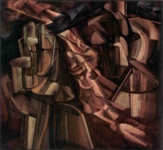
![Figure 2: Marcel Duchamp, Nude Descending a Staircase [No.2], 1912, oil on canvas.](https://www.weber.edu/wsuimages/weberjournal/Archives/14_1/Fig_2_sm.jpg)
